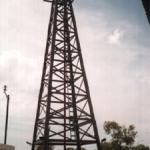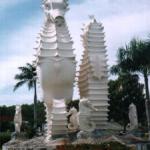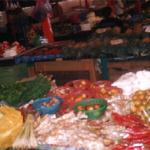Miri, The City of Timber and Oil...
Miri is the third largest town in Sarawak, which is one of the two Malaysian states located on Borneo Island. Miri shares a common border with Brunei and Indonesia and a greater part of it comprises the basin of Sarawak's second longest river, Sungei Baram and its many tributaries including Melinau, Tuboh, Bakong, Tinjar, Liang, Pau, Terawan, Aju, Liang, Lanai, Palutan and many others. Many of these rivers are crocodile-infested. As recent as 29 May 2004, three large crocodiles were captured together when they surfaced to search for food near Bakong Bazaar the main gateway to Miri's timber country.
Geographical Location, Climate and Population
The town of Miri faces the South China Sea and is situated along the banks of the Miri River. The river mouth is close to the town center and a 12-kilometer long peninsula abuts the coast and the town. Part of the town is surrounded by a ridge known as Canada Hill where Malaysia's first oil well, Miri Oil Well Number 1 ( fondly referred to as the Grand Old Lady) successfully struck oil in August 1910.
Miri has a hot equatorial climate with a dry season from April to September and a wet, cooler season from October to March when the monsoon holds sway. The town has about 250000 people with Chinese being the majority followed by Ibans, Bidayuhs, Malays, Melanaus and there are a small minority of the Orang Ulu people (Interior People) such as the Kayans, Kenyahs, Penans, Punans, Kelabits and Berawans who mainly reside in the more remote and forested areas in the Miri's interior.
Getting to Miri and Away
Miri is the gateway to Brunei's capital Bandar Seri Begawan, which is about two hours drive away. Miri is often the stopover point for visitors traveling to the Gunung Mulu National Park. This national park is where the Mulu Caves showpiece and archeological splendor, the Niah Caves is located. Here, visitors can stare in awe at the fragments of a skull belonging to young 40,000-year old homo-sapiens was found in the 1958, experience the legend of the "disappearing" lake, Loagan Bunut, and the mists-shrouded Bario Highlands. Malaysia Airlines (MAS) also connects Miri to the neighboring towns such as Bintulu, Mukah, Marudi, Limbang and Lawas as well to very small isolated hamlets such as Long Lellang, Long Banga, Long Seridan using 18-seater Twin Otter aircraft landing and taking off from short landing strips. There are several MAS direct daily flights from three of Malaysia's international airports namely Kuala Lumpur, Kota Kinabalu and Kuching. The Kuala Lumpur-Miri route is also served by the two-year old no-frills Air Asia.
Hotels, Shopping, Food and Entertainment
Miri caters to many visitors from neighboring oil-rich Brunei with its strong currency-vis-à-vis the Malaysian Ringgit and affluent populace. There is a wide range of accommodation from star-rated international Park City Everly Hotel and Rihga Royal Hotel which are both seaside resort hotels located along Brighton Beach and downtown hotels such as Mega Hotel and Grand Palace Hotel. Many were built during the boom years from the 1980s until the onset of the Asian financial crisis in early 1998. This Asian-wide economic malaise affected Brunei too when Amedeo, a Brunei conglomerate controlled by the Sultan's brother Price Jefri Bolkiah the Finance Minister then collapsed under the weight of US10 billion of debts. It left Brunei a little bit impoverished but only for a short while.
Miri has a number of modern high-rise shopping complexes and other more run-of-mill commercial centers as it is the main commercial hub for towns and villages in its Division as well as those in the Bintulu and Limbang Divisions. Miri offers excellent food and entertainment outlets and there are many pubs, bars, cafes and Karaoke lounges as they serve to attract Bruneians during the Muslim week-ends in view that Brunei is "dry" (alcohol is not allowed). It is an ascetic and conservative Islamic sultanate.
Miri is a seafood paradise and the best place to savor fish, prawns, crabs, squids, clams, mussels and other sea creatures is the Miri Waterfront facing the Miri River mouth. If weather permits one should in the evenings dine alfresco in one of those seafront restaurants with rhythmic sounding names such as Yee Ha Hai (Fish, Prawn and Crab in Cantonese), Vo Vo BBQ or plain vanilla Waterfront Seafood. Enjoy the pleasant sea breeze and watch sand-dredgers and tug boats towing barges containing logs or other bulky produce navigating the narrow channel. Listen to the chugging of their engines and hooting of horns and sirens in the still of the night. They sound as if they were greeting you. Other good choices for seafood are Apollo Seafood, Boulevard Seafood and Maxim Delicious but they are away from the seafront.
For Starters...
The best place to start the tour is to visit the Visitor Information Center (VIC) located within a rock garden near the town center next to Park Hotel and town bus terminal. It was built by the Sarawak Tourism Board to promote tourism in Miri and provide information and service to tourists. Informative brochures are available and the friendly staff would also accept reservations for accommodation for most Sarawak national parks. From here cross the road and head for two open-air connected buildings with Malay names Tamu Muhibbah and Tamu Khas displayed. These are markets where the Penans, Kelabits, Kayans and other Orang Ulu communities ply their wild fruits, jungle ferns such as midin and paku and other wild fruits and vegetables, bamboo and palm shoots and herbs, rattan mats, blow pipes, hand-woven baskets and tuak or rice wine as well as cultivated fruits such as durians, bananas, pineapples, coconuts, pomeloes (Citrus grandis), langsat, jackfruits and other tropical fruits. A popular item is the tasty rice from Bario Highlands. Occasionally animals trapped from the forests such as squirrels, mouse-deer, palm civets and pangolins are also offered for sale.
Cross the road back to VIC, walk pass the bus terminal and through the Wisma Pelita shopping center. Head towards the river and you would see the 1910-built Tua Pek Kong Temple situated at the intersection of China Street and Bendahara Street which together with the area bound by Jalan (Street) Kingsway and Jalan Brooke formed the Old Town. Walk around the Old Town and you would see interesting historical landmarks such as the Fish Market, Central Market and Tamu Lama fronting Jalan Oleander. There is a parade of colors inside this Malay market as the ware on display mainly spices and herbs add much color, splendor and flavor to the market. Your eyes are treated to the kaleidoscopic sight of turmeric, cinnamon, coriander, cumin, curry and mint leaves, lemon grass, chilies, green pepper and cloves as well as bananas, papayas, limau (local oranges), mangoes, melons, pineapples, tomatoes, egg plants, gourds, cucumbers and leafy vegetables.
You would notice in your walkabout that many of the traffic circuses in town are graced with sculptures of seahorses the mascot of Miri town. Walk close to them and you cannot resist the temptation to take snapshots of them.
Visit the Grand Old Lady
Walk up Canada Hill from town center using one of the by-passes and you will see an old derrick at the hill crest. This oil well worked faithfully for SHELL for 62 years and outlived many of the other 624 wells in the Miri Division known as the Miri Land Field. Altogether some 660,000 barrels of oil were produced by the Grand Old Lady. At the site there is a man-size replica of oilmen at work. Have a go working with them! A petroleum museum is being built. Climb up the lookout tower and enjoy a breathtaking view of Miri against the emerald sea. Look in the opposite direction and you will see a grand vista of the countryside. As the Miri oil wells started to run dry new fields were found offshore with participation from Petronas, the state-owned national oil corporation. Malaysia must be lucky to strike the oil bonanza from different parts of the South China Sea in Sarawak, Sabah and Terengganu.
Oil gave birth to the town of Lutong or its moniker, Shell Town where Malaysia's first refinery was commissioned in 1917. Visit Lutong as it is only 10 minutes drive from Miri town center. Pay a visit too to the brand-new branch campus of the Curtin University of Technology of Perth, Australia in nearby Senadin. The setting is just idyllic!
An Island Is Born
Six years ago an island was formed at the Baram river mouth from silt brought down through the ages by the maze-like Baram River and by waves from the South China Sea. The island off Kuala Baram which measures 2.5 kilometers by 1 kilometer resembles a seahorse in its outline when viewed from the air. Hence it was aptly named Seahorse Island. This name is most fitting since the seahorse is Miri's mascot. This island with trees, shrubs and wild grass on it besides crabs and frogfish is getting popular with people from Miri 30 kilometers away.
Calamity Strikes
The first timber mill was built at Kuala Baram in 1904 by the Borneo Company. Until the 1950s Sarawak was virtually deforested as inefficient manual methods were deployed to fell timber and haul logs. The advent of tractors and chain saws changed the equation and transformed the landscape of Sarawak forever. The late 1970s to the early 1990s saw relentless chopping of trees over vast swathes of Sarawak. Many stretches along Baram River and its tributaries were dotted with timber yards stacked high with logs.
From 1987 until the early 1990s there was a running war between the loggers and the Dayaks (term used to refer collectively to the natives of Borneo) over the logging activities. Moreover there was much clear-felling of trees as pre-logged timber lands were converted to oil palm plantations. The disappearing of the forests had deprived forest-dwelling natives of their source of livelihood -- the flora and fauna and their homes as well. Rivers became polluted and fish and prawns became scarce.
Blockades were set up in the logging areas manned by men, women and children and protests and demonstrations were rampant. In 1991 two Penans and a Kelabit visited 25 cities in 13 countries in four continents to champion their cause. One of them brought the campaign to the Earth Summit in Rio de Janeiro in May 1992 and made an address before the 47th session of United Nation's General Assembly in December the same year. Thereafter conflict simmered down as timber companies had to resort to reforestation and practice sustainable forest management such as sustainable logging practices and harvesting methods as buyers required certification that the products came from sustainable sources.
A Geological Wonder
Three kilometers from the town center along the Miri Airport Road, is a cliff face with fascinating geological features exposed. This spot known as the Airport Road Outcrop resulted from hill cutting to realign the road to the airport. At the site visitors and passing motorists and passengers can see clearly the geological faults and deformations with a myriad of colors. They look like a giant paint canvas depicting a piece of Picasso abstract art with colorful striations and strokes.
Conquer Your Fear at Miri Public Park
Within the same vicinity is Miri Public Park the latest attraction of Miri. It affords an opportunity to conquer one's fear of walking on a swaying suspension bridge over a deep valley. Look down from the bridge or lookout tower and you would enjoy a splendid view of the flower gardens and a children playhouse which resembles quaint assembled Lego-blocks.
Miri Fan City
Towards the northern part of the town is Miri City Fan, a public park of fan-shape occupying 26 acres (10.5 hectares). It is an urban civic park rich in cultural, artistic and architectural features and with aesthetic ambience. Its Garden of Vision symbolizes social harmony and progress. The Islamic Garden features Islamic arches and motifs while the Chinese Garden depicts her rich cultural traditions with displays of gazebos, willows, Chinese carps in ponds with a Chinese overhead bridge and a Chinese arch gateway. The Formal Garden has a classical fountain while the Botanical Garden features the rich cultural elements of Sarawak's diverse communities. Within the grounds is Pustaka Miri or Miri IT Library, an amphitheater and a swimming pool. The Library is housed in a two-storey horseshoe-shaped building with a courtyard planted with many scented flowering plants. The whiff of sweet fragrance gives visitors a nice treat to their nasal senses.
The Sea, Sand, Shells and Sunshine
From the second to the fifth kilometer stretch south of the city lies the popular Brighton Beach. After passing the two beach hotels you would come to a recreational park at kilometer 3.5 known as Taman Selera. Care for some mouth watering satay or ice-kacang (ice-gratings with red beans)? There is an open air food and drink food court with a children's playground. Stroll leisurely along the casuarinas-lined beach and stay long enough to enjoy the beautiful, brilliant sunset. Another 9 kilometers away along the same stretch of coast is the Luak Bay Esplanade a popular weekend destination for picnics and outings. There are many newly built seaside mansions many of which are owned by timber tycoons who used them as weekend homes: It just a keeping-up-with-Joneses and lifestyle diversion for them. Just 19 kilometers from Miri is the renowned Hawaii Beach which offers a venue for quietude and undisturbed peace to frolic, catch up with reading or writing or to just do nothing under the swaying coconut palms.
Lian Hua San Temple Presents Photo-taking Opportunities
Fifteen minutes drive out from town center in a residential enclave Krokop is Lian Hia San (Lotus Hill) Temple. It was completed in 2000 and is one of the biggest Taoist temples in South East Asia. The unique building presents Chinese religious architecture and design and offers irresistible photo-taking opportunities. It houses three statues depicting the Taoist deities, Guan-di, Zhang-fei and Lui-bei. A stone's throw away is another Chinese temple built in honor of the Eight Immortals or Ba Xian found in Taoism.
Underwater World of Miri
The Miri Reef is one of the most recently discovered diving spots. Hard and soft corals cover the reefs where anemones, sponges, crinoids, coral fishes and other reef creatures thrive. There are two ship wrecks lying at 18 meters underwater for wreck enthusiasts to explore. The nearest dive is only 15 minutes by boat from the Miri River mouth.
Why Visit Miri?
Miri is such an enchanting and interesting town that there is really no reason to say "No". Many things are currently being done to add new attractions, beautify, and apply touch-up or do some makeover to existing landmarks as part of the master plan to make Miri to become a Healthy Resort City by the year 2005.
Miri beckons you now!
 ThingsAsian
ThingsAsian



















